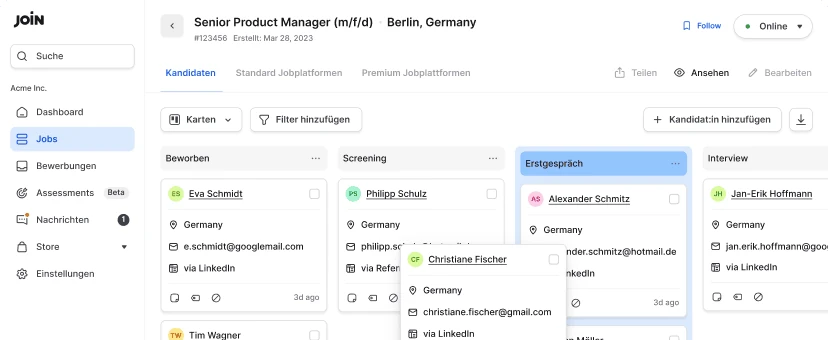How to start analysing your recruitment process
As with all business processes, recruitment is something which gets better the more you understand and adapt your decisions. Therefore, analysing your recruitment is essential if you want to get better at hiring talent.
But, it isn’t as simple as just diving into your data and making changes. If you don’t know what you’re doing, what your goal is, or how to implement the changes you need to make to reach your goal, it’ll be much harder to succeed with recruitment analytics.
Below, we’ll map out the steps you need to take to start analysing and improving your recruiting.
The benefits of analysing your recruitment process
For starters, why would you want to analyse your recruitment process in the first place? What can you gain from this? Well, the answer is a lot!
When you put some time into understanding the strengths, blockers, weaknesses, and missing links in your recruitment, you can improve in leaps and bounds. This can mean:
- Faster hiring – Understanding exactly what is slowing down your recruitment process will mean you can eliminate blockers, and hire faster!
- More quality candidates – Analysing recruitment data and seeing where your most successful hires come from will mean you can hire more qualified candidates in the future.
- Better employer branding – Improving your recruitment process will have benefits for candidates, too, leading to better employer branding.
- An all-around stronger hiring process – Improving your recruitment process will have a knock-on effect on your overall hiring process, meaning your business runs smoother overall!
How to analyse your recruitment process in 5 simple steps
Now you know why you need to analyse your recruitment, it’s time to get started. Kicking off the process can start quickly, and without too much trouble, thanks to these simple steps. So, here’s how you do it!
-
-
Decide which part of your recruitment you want to analyse
Analysing your full process is fine if you have the time, need, resources, and budget. But, in most cases, certainly in smaller businesses, investigating the whole thing is going to be a time-consuming task which you don’t want to undertake if you can help it.
Luckily, most of the time, it isn’t one you need to do! If you’ve already made a few hires or expanded your business, you’ll already have an inkling of what it is you want to improve on. For example, you may want to:
• Learn where you’re losing time in the recruitment process
• Discover which job boards are working for you
• Find which roles are toughest for your business to hire
• Decipher where your budget is being spent
• Cut down the number of stakeholders in your hiring process
• Investigate the diversity of your hiresAll of the above, and more, are possible with the right strategy and recruitment tools.
-
Collect your recruitment data
While each of the above points will require different data types, they will all indeed require some form of data to analyse.
For example, finding out exactly where your budget is going will mean you need to find invoices, bills, or receipts for certain costs, such as recruiting agencies or premium job postings. Accounting software such as Quickbooks or Xero can help with this. However, that may require help from an accounting team.
A more simple method of doing this, especially if your recruitment is done in-house, is through the use of a recruitment automation tool with budgeting capabilities or an Applicant Tracking System (ATS). This allows you to spend budget on premium job ads, multiposting, or boosting listings on certain job boards and keep this data inside the tool to track later.
In some tools, such as JOIN, you can even preset the budget and get suggestions on how to spend it!
![]()
A recruitment automation tool is also a great way to save data on which job boards are working for you, as with a good ATS you’ll be able to see where candidates are applying from. You’ll also be able to see data such as how long a position is or was open for, and in some tools you can even track which internal team members collaborated on a hire.
In short, a recruitment automation tool or ATS is the perfect way to collect data for recruitment analytics.
-
Create a recruitment analytics report
Once your data is collected, it might be tempting to jump right into action and start working on the areas you’ve identified need improvement.
However, it is a good idea to slow down and first create a report. This report should contain the data you’ve collected, findings from said data, actions you will take, and when you’ll take them.
For example, imagine you’ve identified a good portion of your budget goes to posting roles on LinkedIn, but only a small percentage of applications come from there. Your report should then note something similar to:
• LinkedIn budget: €500
• Percentage of applicants coming from LinkedIn: 10%
• Findings: Too much budget being spent on LinkedIn
• Action: Move budget from LinkedIn to better-performing platformsHaving a detailed report allows you to keep track of any changes you make to your process so that if something goes wrong or has a great impact, you can be sure of what it was.
-
Implement your recruitment improvements
Now you’ve got your data and reporting to hand, you can implement your improvements.
If you’ve got multiple large changes that needed to be made, such as cutting multiple stakeholders out of your hiring process, it might be an idea to stagger these stages over time. This means any changes can easily be reverted if a negative impact on your process was seen.
Alongside this, it is a good idea to be transparent with the team as these changes are made to avoid any confusion along the way.
Other steps, such as redirecting the budget away from job boards that aren’t working for you might require a little more research. Using the LinkedIn example above again, if you’ve discovered that large generalist job boards aren’t working, you might need to spend a little time trying out niche job boards or diversity job boards instead.
Implementing this step, therefore, can require a little trial and error. So, keeping note of what you try is essential.
-
Track the impact on your recruitment
Of course, once the changes are made, this isn’t the end of your recruitment analytics journey. It’s a good idea to keep an eye on these changes. This can be done the same way as you collected your original data in step one.
Additionally, you can gauge stakeholders’ opinions in your recruitment process through surveys, feedback sessions, or one-to-one conversations. The same can be done to measure the impact on candidate satisfaction through quick surveys!
-
Taking your recruitment analytics further
These simple steps can help you to get started with analysing your recruitment. However, it is by no means an exhaustive process.
Depending on your resources and tools, there are plenty of other ways you can use data analytics in your recruitment process. This can include hiring a specialist data analytics team, tracking traffic to your careers page, or investing in a full employer branding campaign.
Amber Denwood
Amber Denwood was a Content Manager at JOIN. She mostly wrote about employer branding, trying to help companies to understand how they can improve their image.



